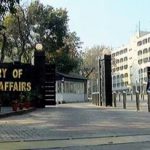By Muhammad Aatif Ismeel
MULTAN, Jun 23 (APP):Blue pottery, a unique and centuries old art of south Punjab is on verge of extinction whereas its revival can help improve socio-economic uplift of the region.
Some serious efforts for revival of the cultural identity are also in progress, with special focus on socio economic uplift by creation of employment opportunities for the youth.
The Kashigari (designing) work on pots is a traditional art of south Punjab. The blue pottery art originated from China and reached sub-continent via Iran. Similarly, When Arabs entered Sindh Valley and Muhammad Bin Qasim conquered Multan in 712 A.D, he was also accompanied by some experts of “Kashi”.
The experts settled here and they developed this art to earn their livelihood. Their favorite colour was blue. Multan had hundreds of shrines and other historic buildings and all these buildings contained three shades of the blue colour, stated Manager, Institute of Blue Pottery Development (IBPD), Qazi Asad Khan while talking to this scribe.
About word Kashigari, he revealed that the word was related to “Koshan”, the famous city of Iran, and “Kashgar”, a popular city of China. The art became very popular and was transferred from one generation to another. Due to least interest, taken by its custodians, the art of Kashi was at verge of extinction.
In order to revive heritage art of the local region, Institute of Blue Pottery Development (IBPD) Multan was striving hard to keep the art alive and hence to promote cultural identity of the region.
Some serious efforts for revival of the cultural identity were also in progress with special focus on socio-economic uplift by creation of employment opportunities for the youth, said the manager IBPD.
The Institute was working to provide training to students,offer common facility services to local blue pottery manufacturing units, conduct research, exploration of cheapest pottery raw material, and develop suitable designs, which could not only depict culture and history of the country but also meet modern requirements, the manager added.
“The Institute of Blue Pottery Development was preparing over 350 articles including complete range of dinner-set, water-set, tea-set, soup-set, show-pieces, planters and many other things, ” informed another official and deputy manager (IBPD) Muhammad Naveed Jameel. He also stated that IBPD used to purchase raw clay from Tharparkar, Swat, and Quetta.
IBPD was playing important role in revival of the blue pots Naveed said adding, over 1200 students had got training in the Institute. Although, the Institute was established in 1985 in the city but classes for students were being organized since 2006. He stated that IBPD was working under supervision of Ministry of Industries. “The students are also given scholarships amounting to Rs 3000 and Rs 2000, in line with different programmes of Technical Education and Vocational Training Authority (TEVTA)”.
“Currently, 140 students are availing training facility in different trades, including Kashigari, Mould making, Casting in Ceramics and Firing Techniques in Ceramics”, he added.
The Institute was also working on some other courses including Ceramics-I, Computer Graphics, Art and Designing Specialization in Kashigrai, Sculpture, Calligraphy, Auto CAD/CCA, Naveed hinted adding that IBPD has capacity to enroll 800 students annually. Naveed stated that a good number of girls from universities and colleges, were also learning art of Kashigari in the Institute.
When questioned about future of Blue Pottery, the Marketing Manager (IBPD) Shabbir Qasuri maintained that blue pots were very much liked by masses, especially elite class families and foreigners. Similarly, blue pots were also favourite choice of big hotels and restaurants. ” One could observe presence of these unique blue pots in any big hotel across the country”, he claimed.
About cost, Qasuri stated that these were costly utensils. He, however, added that price of one dinner set was Rs 28,000.
Qasuri also remarked that the blue pots were beauty of dinning tables. He stated that citizens could also avail broken or lost articles of dinner set from the Institute and thus maintain complete set for long time in kitchen.
Deputy Manager IBPD Naveed also informed that about scores of ambassadors from various countries had visited the Institute on different occasions. They expressed keenness in blue pots.
Similarly, foreigners also contacted Institute’s administration for purchasing the pots.
About Kashigar’s income estimate, he said that a master kashigar could earn more than Rs 40,000 per month. He observed that the students, who acquired training from the Institute, were working in Karachi, Lahore, Gujranwala,Faisalabad and some
other places.
Muhammad Imran, a master Kashigar, informed that blue pots manufacturing was not an easy task. It required proper skill and commitment. He informed about various operations including body formation, filtration, slip formation, casting, pug milling, jiggering, cutting & joining, drying, finishing, biscuit firing, kashi, cleaning, glazing and glost firing. About temperature management, he informed that pots were baked on 1200 Celsius degree.
He said the temperature was regulated very carefully in order to prevent pots from cracking. The designer Muhammad Imran also expressed pleasure that he was earning a handsome amount. He floated the suggestion that unemployed youth should learn the unique skill as it would bring healthy socio-economic change in their lives.







